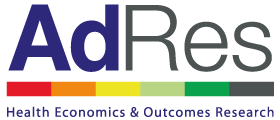THE INDIVIDUAL RESULT IS MULTIPLIED THROUGH TEAMWORK
AdRes offers and runs specific residential training programmes on pharmacoeconomics topics and techniques. The training is customised to meet the specific needs of the client. With heor training, you offer your team the power to:
. engage colleagues in HEOR discussions
. interpret HEOR studies
. communicate HEOR data more effectively
. understand how analyses are used by decision makers
Training modules designed especially for your team. Some examples
To define pharmaco-economics research and its use and identify ways in which a drug can be considered ‘cost-effective. To distinguish between types of costs (direct medical, direct non-medical, indirect, intangible), describe types of outcomes -e.g. surrogate vs. final, economic, clinical, patient reported- and how they are incorporated into cost-effectiveness analyses.
Know how to interpret a cost-effectiveness plan, describe the various study perspectives and identify the importance of sensitivity analysis.
To identify the differences between various pharmaco-economic methodologies, such as disease cost analysis, cost-minimisation analysis, cost-effectiveness analysis, cost-utility analysis and cost-benefit analysis.
Calculate the incremental cost-effectiveness for one drug compared to another.
Describe how utility values are used to calculate a difference in life years for quality between average cost-effectiveness ratios and incremental cost-effectiveness ratios.
Describe the advantages of using cost-effectiveness acceptability curves.
To define patient-reported outcomes (PROs) and when they should be used.
To identify the types of instruments used to measure PROs, including generic and disease-specific instruments.
Describe examples of commonly used PRO instruments, including the SF-36 health survey and the EQ-5D.
Assess the need to measure what is important to the patient and outline the recommendations in the PRO Guide.
Explain how a PRO instrument can be considered valid and reliable.
- REAL WORLD EVIDENCE. METHODS OVERVIEW
- HEALTH ECONOMICS MODELLING. BASIC AND ADVANCED NOTIONS
- Budget Impact Analysis (BIA)
To clarify definitions and policy issues, and why RWE has received so much attention from various stakeholders. To describe the different types of RWE studies, including their advantages and disadvantages. Differentiate the designs of observational studies, including cohort: case-control and pragmatic studies. Discuss statistical techniques used in observational research such as propensity score matching. Compare and contrast the various tools available for evaluating observational studies.
To describe the steps in constructing a decision tree using Excel software.
To differentiate between decision trees and Markov models and identify disease conditions in which a Markov analysis is preferred to a decision tree.
Construct a Markov model using Excel software.
Interpret Markov structures and results presented in publications,
Fully probabilistic Markov/Monte Carlo models (based on Bayesian statistics)
DES models (simulation of discrete events)
To define the components included in budget impact analyses and discuss the ISPOR principles of good practice for budget impact analysis.
To describe examples of published budget impact analyses and identify key questions that are raised about budget impact analyses.
Outline the differences between budget impact and pharmaco-economic analyses.
Discuss ways to best communicate budget impact models with end users.




